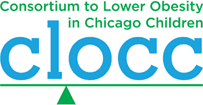Research and Evaluation
Publications and Reports
CLOCC and the Child Health Data Lab are pleased to present findings from the 2011-2012 fielding of the Illinois Health Survey for Youth (IHSY). IHSY is a random digit dial survey designed to obtain information from caregivers about the health and healthcare of children under 18 years old in their care. Healthy Places will be releasing periodic data briefs on various areas of focus examined in the IHSY.
Breastfeeding Rates and Perceptions
Data support the need for Chicago hospitals to have institutionalized policies and systems that support breastfeeding, particularly for areas that serve a low-income patient population. As a part of Healthy Places, the Illinois Health Survey for Youth polled parents about their views of breastfeeding and the prevalence of breastfeeding among Chicago families. Survey results showed that race and ethnicity play a role in a child’s likelihood of being breastfed as an infant, and both race and income influence preferences for a hospital that provides free baby formula to new parents. Better institutionalized hospital policies may therefore assist those less likely to breastfeed.
Related Interest Group(s): Research and Evaluation
Related Topics: Publications and Reports
Health Gaps in Chicago’s Children
Data show that Chicago children need significant support in order to incorporate healthy options into their routine. As a part of Healthy Places, the Illinois Health Survey for Youth polled caregivers about the health and healthcare of children under 18 years old as it relates to the 5 criteria of 5-4-3-2-1 Go!, a healthy lifestyle message designed to create an easy way to remember how to eat healthy and embrace an active lifestyle. Eight years ago, the Consortium to Lower Obesity in Chicago Children (CLOCC) developed 5-4-3-2-1 Go! to promote these daily recommendations for children and families: 5 servings of fruits and vegetables, 4 servings of water, 3 servings of low-fat dairy, 2 hours or less of screen time, and 1 hour or more of physical activity. Survey results show that fewer than 40 percent of Chicago children aged 0-17 years meet any of the 5 daily recommendations, with the lowest percentage of achievement around the active play criteria. Low-income and minority children hold the greatest risk of not meeting most goals.
Related Interest Group(s): Research and Evaluation
Related Topics: Publications and Reports
Parents Support Healthy Environments in Chicago
Data show that there is parent support for government involvement to promote healthy communities. As part of Healthy Places, the Illinois Health Survey for Youth polled parents on their views on the role of government in creating healthy communities. Support for government, and the willingness to pay higher taxes for this involvement, is very high.
Related Interest Group(s): Research and Evaluation
Related Topics: Publications and Reports
The Dietary Guidelines for Americans
https://health.gov/dietaryguidelines/2015/guidelines/
The HHS Dietary Guidelines for Americans 2015 – 2020
Related Interest Group(s): Food and Beverage, Health Education, Schools, Policy and Advocacy
Related Topics: General Resources, National Resources, Prevention and Intervention, Publications and Reports
U.S. Department of Education PEP Report Update Year 2
Chicago Public Schools received funding from the U.S. Department of Education to implement the Carol M. White Physical Education Program (PEP). This effort seeks to advance and institutionalize changes to CPS’s existing physical education program. PEP will enable the district to address the areas for growth identified through school health inventories and CPS wellness assessments, including meeting state learning standards and physical activity (PA) time requirements, offering consistent professional development and resources tailored to the needs of PE teachers, and building infrastructure to collect and assess data related to PE and student physical activity. PEP will also help the district maintain and increase attention to the importance of a high-quality PE programing for positive physical health, behavior and academic outcomes to ensure that all CPS students have the knowledge, skills and confidence for academic success and lifelong health.
CLOCC is serving as the evaluators of the PEP project. The evaluation is assessing the PEP project on reaching its goals around individual, student level physical activity acquisition and fruit and vegetable consumption. Interim findings on specific student level outcomes, requested by the U.S. Department of Education, from the first four rounds of data collection are included in these reports.
The goal of this effort is to collect an adequately powered sample of student-level data regarding physical activity and nutrition behaviors from students attending CPS elementary and high schools implementing PEP. Data is collected from a random sample of students attending participating schools in the spring and fall of 2014, spring, fall and winter of 2015 and the spring of 2016. Approximately 477 students are recruited at each time point.
All participating students are asked to wear a pedometer for one week, complete a survey addressing nutrition and physical activity opportunities and behaviors, and complete 5 of the Fitnessgram fitness measures. A 3-day physical activity recall is completed by students in 5th grade and above.
Results from year one can be found here.
Finding Highlight:
In addition to the data presented in these reports, we found a statistically significant improvement from baseline to year one in the proportion of students which obtained 60 minutes or more of moderate/vigorous physical activity, increasing from 12.4% at baseline to 25.0% in year one (p<0.001). Similarly, the proportion of students which obtained 60 minutes or more of moderate/vigorous physical activity was higher at year two, compared to baseline (from 12.4% to 32.0%; p<0.00001). This finding that the proportion meeting the physical activity goal is higher after the initiative is an encouraging outcome for the intervention which targets increased PE time and quality. The proportion of students with Healthy Fitness Zone scores was not significantly different between baseline and year one or year two (p=0.34 from baseline to year one; p=0.75 from baseline to year two). Changes in healthy eating habits were not significant (p=0.92 from baseline to year one; p=0.28 from baseline to year two)
Related Interest Group(s): Research and Evaluation
Related Topics: Publications and Reports

